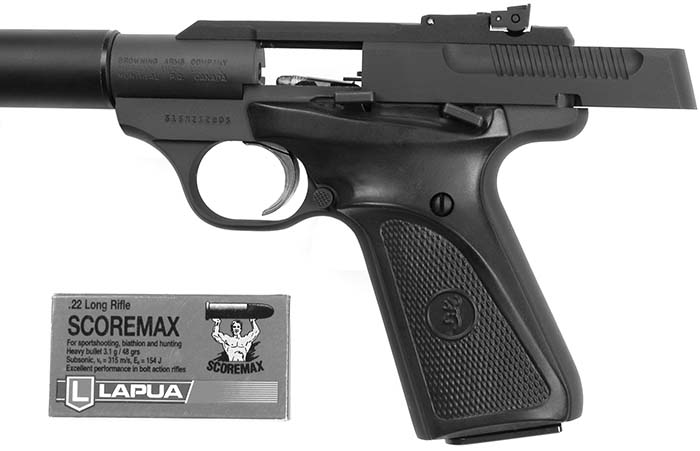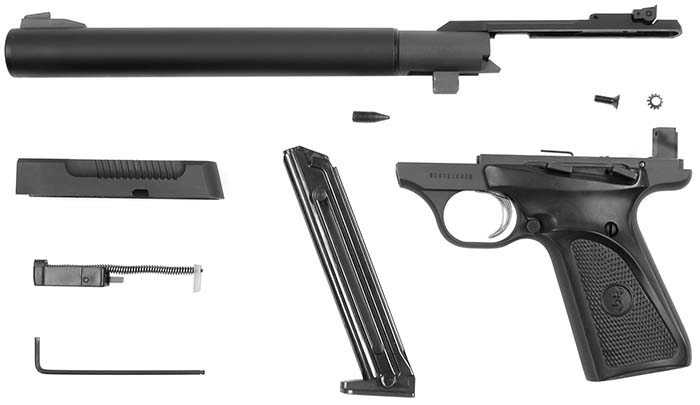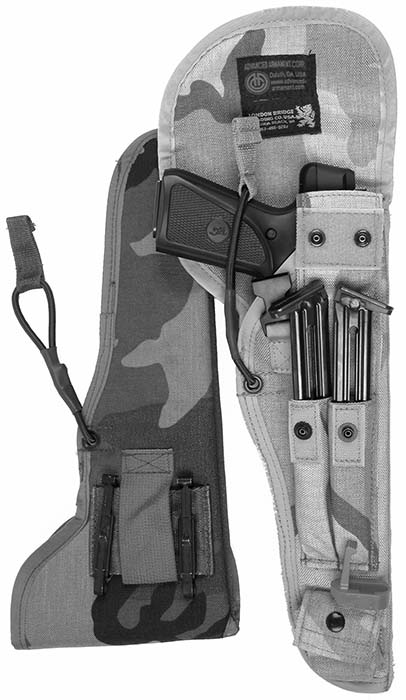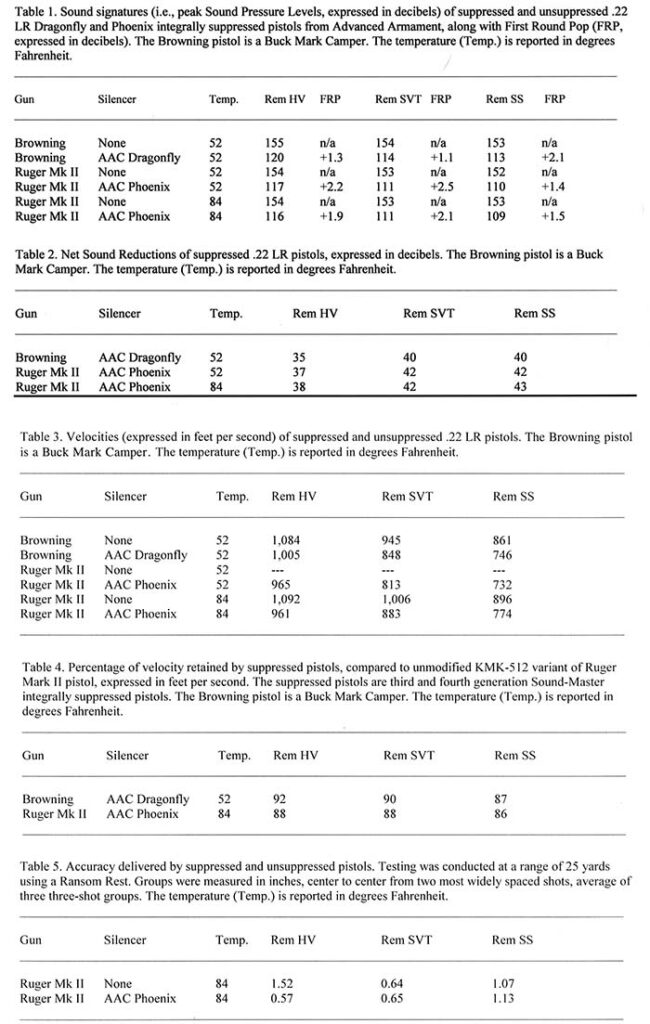By Al Paulson
Few firearms exhibit such a graceful marriage of form and function as the integrally silenced Ruger Mark II. The Ruger is both accurate and durable, as well as handsome. Yet one does hear a few gripes from time to time about how quickly the Ruger action gunks up with powder residue, how difficult the action is to clean and reassemble after field stripping, and how heavy the suppressed Ruger is both for extended carry as well as for kids, and wives, and first-time shooters. Some folks are simply bored with the Ruger and want something different. Unfortunately, few accurate, robust, and practical-to-suppressed alternative pistols have appeared over the years. Therefore, integrally suppressed Ruger pistols have dominated the suppressed .22 pistol marketplace since the Vietnam era. An attractive and viable alternative to the Ruger appeared in 1999 with the introduction of the Camper model of the Browning Buck Mark.
Unlike the Ruger, which has an ejection port on the right side of the receiver, the Browning has an open receiver when the slide recoils back during the action sequence. This enables the back pressure of combustion gases to blast unburned powder residue out both sides of the action, keeping it much cleaner than a Ruger action after firing the same number of rounds. While the suppressed Ruger action needs to be cleaned every 500 rounds, the suppressed Browning action only needs cleaning every 1,500 rounds. That’s a big plus for many sport shooters and animal-control professionals.
The Browning Buck Mark Camper is also lighter than a comparable Ruger. With a bull barrel length of 5.5 inches and an overall length of 9.5 inches, the Browning Camper weighs 34 ounces. A Ruger KMK-512 with 5.5-inch bull barrel has an overall length of 9.75 inches and weighs 42 ounces. It is the KMK-512 model that is commonly used for high-end integrally suppressed Ruger pistols, such as AAC’s Phoenix pistol. The Browning Camper is also about $160 less expensive than the Ruger KMK-512. Other noteworthy features of the Browning Camper include molded rubber grips, a top strap above the slide for mounting the a fully adjustable rear sight (which does not move back and forth with the slide), and an unusually nice factory trigger nominally set for 3.5 pounds. The test specimen used in this study started out with a trigger pull of 4.1 pounds when factory fresh. Pull dropped to 3.7 pounds after the first 200 rounds had been fired.

The Dragonfly from the Advanced Armament Corp. represents an attempt to marry the lightest possible suppressor to the Buck Mark Camper pistol to capitalize on the light weight of the Browning handgun. The Dragonfly suppressor is fabricated from 6061-T6 aluminum and 304 stainless steel. (The Buck Mark frame is machined from a block of 7075-T6 aluminum.) The suppressor tube is 7.25 inches long and 1.0-inch in diameter, and is finished in a matte black anodizing. The barrel is turned down to save weight, and it is placed under tons of tension to minimize barrel harmonics and drift from heating, thereby maximizing accuracy. The suppressed Browning Camper pistol has an overall length of 13.5 inches and a weight of 30 ounces with an empty magazine. Thus the Dragonfly is 2.2 inches longer and yet 4 ounces lighter than the unmodified Browning Camper pistol. The light weight and longer sight radius, plus the fact that this is a silenced pistol, mean that the Dragonfly will be particularly kind to new shooters and shooters of small stature like kids.
These same characteristics make this an ideal firearm for training individuals in beginning pistol safety and marksmanship. As an NRA instructor, I’ve used silenced pistols for teaching since the 1980s. It is much easier to teach and to maintain safe gun handling practices when students are not encumbered by shooting muffs or plugs. It is also worth noting that shooting muffs frequently do not seal well on the smaller heads of young people, and plugs may be painfully large in the smaller ear canals of the young. This problem is made more serious by the fact that the young are more susceptible to hearing loss from gunshot noise. A pretty good shooting muff that will still allow a cheek weld on a long arm, such as the Peltor Bullseye 9 model, drops noise by 22 decibels. That assumes that the muff obtains a perfect seal on the head, which may be problematic with small-statured individuals. Peltor recognized this problem and introduced a Junior model, which only drops noise by 17 dB, but at least it’s much more likely to seal properly on a youngster. Peltor is certainly to be commended for introducing a muff for youth and small adults. Clearly, any sound suppressor that produces more than 17-22 dB sound reduction (kid versus adult muffs) will not only give better hearing protection than the shooting muffs, it will also provide a much better environment for teaching basic shooting fundamentals and fostering safe gun handling on the range or at the family picnic.
Then there is the matter of aesthetics. Are you bored with the looks of silenced Ruger pistols? Browning offered a special run of Camper frame colors in red, green and blue for the most exuberant tastes, as well as black for stodgy traditionalists like myself. AAC stocks Dragonflies in all of those Browning frame colors.
By way of comparison to the Dragonfly, AAC’s integrally silenced Ruger Mark II, called the Phoenix, has a 7.5-inch stainless steel suppressor tube and weighs 42.5 ounces with empty magazine. That’s only 1.1 ounces heavier than an unmodified KMK-512 pistol. While that’s relatively light as suppressed Ruger pistols go, it’s still 12.5 ounces heavier than the suppressed Dragonfly.
In the history U.S. folklore and firearms development, the story of the late Bill Ruger’s Mark I and Mark II pistols are probably as well known as the chapter on Sam Colt’s .45 caliber Peacemaker. Most folks are not particularly well versed on the origins of the Browning Buck Mark series, however, so a very brief history is in order before we conduct a hands-on evaluation of AAC’s Dragonfly. Advanced Armament’s suppressed Browning was tested against AAC’s suppressed Ruger (a Phoenix), which was used as a frame of reference.

Buck Mark Origins
In the beginning… (which in this case means anno franca 1914), John Moses Browning created the Colt .22 Automatic Target Pistol. And it was good.
In fact, it was dandy. Colt began production on March 29, 1915. Browning’s pistol featured a rather unusual innovation. A slide ran along the top of the receiver for the rear half of its length, and it separated completely from the breech end of the barrel upon firing. Combustion gases pushing on the spent case drove the slide rearward from the fixed barrel to power the extraction/ejection sequence of this simple blowback design.
The magazine was redesigned to accept high-speed ammunition about 1920, and the pistol was subsequently renamed the Colt Woodsman in 1927 (Browning and Gentry, 1964, 1994). Various target and sporting models were introduced and in the 1930s, but were discontinued in 1940 with the appearance of war clouds on the horizon. Two post-war Woodsman variants appeared in 1947 (a sporting and a target model). An economy model was introduced as the Challenger, which was renamed the Huntsman in 1955. Colt production ended in January 1963 with a total production of 539,232 Woodman pistols of all models.
If imitation is the highest form of flattery, then the original Woodsman was indeed a praiseworthy design, judging by how many times the Woodsman’s basic blowback design principles and overall aesthetics have been copied over the intervening nine decades. Fabrique Nationale d’Armes de Guerre of Belgium produced many Browning designs under license for the Browning branch of FN’s product line. John M. Browning began his relationship with FN by signing a contract on July 17, 1897 for exclusive world rights to manufacture and sell his .32 caliber self-loading pistol, which was marketed as the Browning Model 1900.
A half-century after its introduction by Colt, grandson Bruce Browning redesigned the Woodsman for Fabrique Nationale to take advantage of new processes and materials to streamline manufacturing and reduce production costs. Here’s where the story gets a bit hard to follow, depending upon which historian you read. Part of the problem is that model names appear to overlap different actual designs, and more recent work that came to hand does not cover all the important basic models I’ve seen myself.

W.H.B. Smith (1966) says that Browning simultaneously introduced three improved pistols based upon the earlier Woodsman design in December 1961, but commercial production did not actually begin until 1962. All three of the new pistols featured non-recoiling sights, open sides but a covered top of the receiver, and a barrel that could be removed by loosening a slotted screw with a coin. The Browning Medalist was a high-end target pistol with many advanced features, and the Challenger was a more affordable target pistol without the ventilated rib, thumb-rest stocks, wood fore end, or other bells and whistles of the Medalist. Both featured a steel frame, slide hold-open latch, adjustable trigger, and checkered walnut stocks. The Nomad, according to Smith, featured an aluminum frame to reduce weight and-more importantly-to reduce production costs. The Nomad had plastic stocks, an open rear half of the receiver like the modern Buck Mark, and neither an adjustable trigger nor slide hold-open latch. This economy model of the Browning line featured an aluminum frame from its introduction until 1966, when a steel frame was introduced for the Nomad.
As has been the trend of all firearms designs of old world lineage, eventually even the new Nomad econo-pistol itself became too expensive to manufacture. According to one recently published history of the Browning Buck Mark: Lee Farber, the owner of Arms Technology, Inc. (ATI) in Salt Lake City, redesigned the Nomad. That’s not really true. Browning’s own Joe Badali redesigned the pistol and Farber “industrialized” it. This means Farber performed the critical task of making Badali’s new design efficient and economical to produce, by using such gambits as using investment castings of the slide and other small components to reduce costs. Fielding an excellent product depends upon both a gifted designer and a gifted industrializer. These are rarely overlapping skills. This descendant of the Woodsman reached the marketplace in 1976 as the Challenger II (not to be confused with the 1960s-vintage Challenger, now referred to the Challenger I). The Challenger II featured a sporter-weight barrel, an open slide at the back, and a steel frame.
After further redesign of the pistol and magazine by Joe Badali, the Challenger III pistol appeared in 1982. It featured an aluminum frame and a target-weight barrel. Next Badali incorporated the latest advances in both manufacturing technology and metallurgy into the Challenger III, producing the latest Woodsman descendant—the Buck Mark, which first appeared in 1985.
It is safe to say that the Buck Mark represented a big improvement over the evolving Challenger series, and it also brought the fabrication of Browning .22 pistols back to the States from Belgium. Buck Marks are manufactured for the Browning Arms Company of Morgan, Utah, by Arms Technology, Inc. of Salt Lake City.

The first Buck Mark had a simple stamped rear sight. A more heavy-duty, somewhat adjustable rear sight appeared several years later for target pistols. Then Joe Badali developed a new rear sight for target models that was much more durable than previous Browning adjustable sights. Introduced in 1992, the new Pro-Target Sight was more user-friendly for several reasons. The new rear sight offered finer adjustment and significantly more surface area contact between the grooves in the adjustment screws and the captive detents. This substantially improved the lifespan of the sight as well made sight adjustments much more positive. Improved metallurgy also improved sight life. Although originally designed for the Buck Mark Silhouette pistol, the new sight proved to be so outstanding—and so economical to produce—that it became standard issue on all models within the Buck Mark line, including the pistol AAC uses to create the Dragonfly.
Another big improvement of the Buck Mark over the Challenger series was the superior trigger mechanism, which quickly became known for its crisp let-off as well as lack of creep and play. The sears of all two dozen or so variants currently in the Buck Mark line are stoned for smoothness. Some target models feature fully adjustable triggers with stops to eliminate overtravel.
The Browning Buck Mark Camper model pistol that is used by Advanced Armament as the basis for its integrally suppressed Dragonfly pistol is Browning’s answer to the Ruger KM-512 and KMK-512 pistols. The Buck Mark represents nearly twice evolutionary history as the Ruger pistols. The Browning Camper is a competitive and timely pistol that entered the marketplace in 1999. The Camper is the product of a timeless design being improved gradually by generations of inspired designers over the course of nearly a century.
Silenced Pistol Performance
Performance of AAC’s Dragonfly was compared to unsuppressed and suppressed benchmarks. Unsuppressed benchmarks included the Browning Buck Mark Challenger and the Ruger Mark II. The suppressed benchmarks included AAC’s integrally suppressed Ruger known as the Phoenix pistol. The benchmarks were shot the same day as the Dragonfly, and these data were compared to an earlier test of the Phoenix. This study employed the testing regimen and equipment used by Paulson (1996) as amended by Paulson, Parker, and Kokalis (2002). I should also note, for the record, that when I gave Browning the opportunity to critique this article before publication, they still wanted to recommend cleaning the Buck Mark every 500 rounds for optimum performance, despite the fact that the gun can go for 1,500 rounds with clean ammunition.
The peak sound pressure levels (SPLs) of suppressed and unsuppressed pistols are reported in Table 1. Net sound reductions appear in Table 2. Muzzle velocities appear in Table 3. The percentage of velocity retained by suppressed pistols, compared to unmodified KMK-512 variant of Ruger Mark II pistol, appear in Table 4. Accuracy data appear in Table 5.

Did I find anything that I didn’t like that doesn’t appear in the data? I did find one nitpicking detail inherent in the Woodsman/Buck Mark lineage. This final observation relates to the fact that the receiver is open on both sides, which enables the back pressure of combustion gases to keep the Browning action much cleaner than a Ruger action. There is no free lunch. The gas and gunk have to go somewhere. The more open receiver design liberates gas and particulates toward both of the shooter’s forearms when using a two-handed stance. Also, a warm powder charge may open the bolt prematurely and direct effluvium toward the shooter’s face upon rare occasion via the open receiver. Therefore, eye protection (which should be mandatory anyway) is doubly advisable with this design.
In terms of handling the Dragonfly, the first thing one notices is its conspicuous lack of weight. This is a good thing for folks without musculature developed for handgun shooting, since it will reduce shooter fatigue and significantly extend shooting sessions. Although I prefer more weight to steady my aim upon firing, I quickly adapted. I consistently hit a 2-inch swinging metal target at 25 yards, shooting rapid fire from the standing offhand position. This was comparable practical accuracy to AAC’s Phoenix pistol fired on the same day. The same Phoenix delivered 0.57-inch groups with Remington HV ammo when fired from a Ransom Rest (see Table 4). A Browning Buck Mark insert for the Ransom Rest could not be obtained in time for this study to provide a rigorous analysis of the Dragonfly’s intrinsic accuracy.
In terms of sound reduction, it is interesting that the ultralight Dragonfly was only 1 decibel louder than the Phoenix shot on the same day under the same weather conditions, regardless of the ammunition used. The Dragonfly delivered an impressive 35 dB sound reduction with Remington High Velocity ammo, and it did so while delivering a muzzle velocity of 1,005 fps. That’s virtually the ideal velocity (1,000 fps) for providing the optimum mix of penetration, flat trajectory, and lack of ballistic crack over a wide range of temperatures. Achieving solid sound reduction without overly reducing projectile velocity is a most welcome design decision for anyone who may use the Dragonfly for hunting, animal control, or the selective destruction of objects (if one is an armed professional). Advanced Armament gets bonus points for optimum projectile velocity. It is also interesting that the Dragonfly retains a slightly larger percentage of velocity—compared to an unmodified parent pistol-than the Phoenix.
AAC gets higher marks for the 40 dB sound reduction delivered by standard velocity and subsonic ammunition. A suppressed .22 pistol that delivers 40 dB or more sound reduction has entered the realm of the Holy Grail.
Using the sound of the bolt closing on an empty chamber at 52 degrees Fahrenheit as the yardstick, AAC’s Dragonfly had an action noise of 110 dB, while AAC’s Phoenix had an action noise of 109 dB. Using subsonic fodder, the Buck Mark/Dragonfly delivered a mean (average) sound signature that was within 3 dB of action noise. The Ruger/Phoenix produced mean sound signatures that either equaled or were 1 dB louder than action noise, depending upon temperature. This is dandy performance.
Both the Dragonfly and the Phoenix get serious bonus points because they cycle flawlessly with subsonic fodder. Not every integrally suppressed pistol does, particularly if they have aggressive barrel porting.
What’s the bottom line? Advanced Armament’s Dragonfly integrally silenced Browning Buck Mark pistol is handsome, lightweight, quiet, accurate, user-friendly, relatively maintenance-free compared to a silenced Ruger, and downright fun. The Dragonfly is a lot of pistol for $795 retail (or $695 for a silenced barrel assembly with front sight). I give Advanced Armament’s Dragonfly two enthusiastic thumbs up.
Literature Cited
Browning, John, and Curt Gentry. 1964. John M. Browning; American gunmaker. Doubleday & Company, Inc., New York. 323 pp.
Browning, John, and Curt Gentry. 1994. John M. Browning; American gunmaker. Second edition. Browning Arms Co., Morgan, UT. 390 pp.
Paulson, A.C. 1996. Silencer history and performance. Volume 1. Sporting and tactical silencers. Paladin Press, Boulder, CO. 424 pp.
Paulson, A.C, N.R. Parker. 2002. Silencer history and performance. Volume 2. CQB, assault rifle, and sniper technology. Paladin Press, Boulder, CO. 429 pp.
Smith, W.H.B. 1966. Book of pistols and revolvers. Sixth edition. Stackpole Books, Harrisburg, PA. 752 pp.
Sources
Advanced Armament Corp.
Dept. SAR
3100 Five Forks Trickum Road SW, Suite 201
Lilburn, GA 30047
Phone 770-985-3109
Fax 770-985-3110
Website: www.advanced-armament.com
Aero Peltor
Dept. SAR
90 Mechanic Street
Southbridge, MA 01550
Phone 508-764-5500
Fax 508-764-0188
Browning Arms Co.
Dept. SAR
One Browning Place
Morgan, UT 84050
Phone 801-876-2711
Fax 801-876-3331
Website: www.browning.com
Greg Cartmell
Cartmell Gallery
609 22nd Avenue
Meridian, MS 39301
Phone 601-485-1122
Website: www.cartmellgallery.com
| This article first appeared in Small Arms Review V7N1 (October 2003) |











